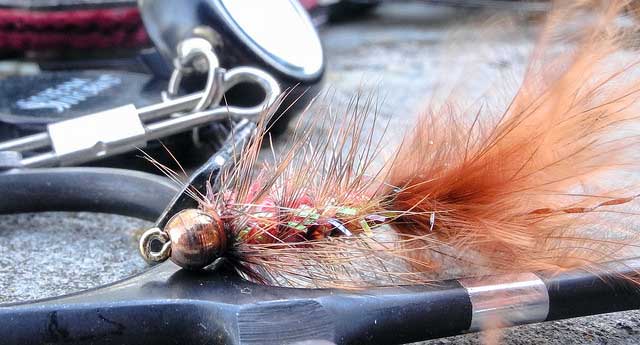Hacking High Water

Mark Sides photo
In much of the country, an endless winter has given way to a soggy—make that sopping—spring. And with climate scientists predicting more extreme weather in the form of summer storms, those days of high water and limited visibility might become more common than we’d like. For this week’s column we surveyed a range of guides and asked them what they do when confronted with muddied or even blown-out conditions.
Mat Wagner runs the Driftless Angler fly shop in the heart of Wisconsin’s Driftless region, which in 2008 saw a “1,000-year flood.” “We were literally catching trout in cornfields,” he said. Mat’s spring creek advice? “Swing a larger leech or streamer—with a San Juan dropper—downstream. Whatever you do, don’t neglect the riffles and do let the fly pause downstream for at least a 5 count before recasting.”
Fellow spring creek guide Charlie Piette advocates paying particular attention to soft inside seams where CFS-battered fish recuperate. He also recommends changing your attitude about fishing garden hackle: “If the San Juan hatch is on, don’t loathe it, love it!”
Western Michigan guide Steve Cornetet suggests forgetting about the river that was and paying attention to the river that is. “Forget everything you know about how things normally are, especially if it’s a river you know well. Instead, read the high water as a new river. There are going to be new seams, and they might not be where you expect them. And don’t forget to run heavier line. You will need it—especially with salmon and steelhead—and you can get away with it in these conditions.”
For Wisconsin smallmouth guide Bart Landwehr, it’s all about playing to the fish’s senses of detection as acutely as possible. “I like patterns that move a lot of water, patterns that are darker and therefore easier to see, and patterns that rattle. Covering these bases increases the chance of a big fish zeroing in for the kill.”
Steelhead Alley guide and spey tier extraordinaire Greg Senyo fishes high and off-colored water more often than not. “The best presentations are to go wildly large on your fly offering, at time 6-7 inches long! You can go bright or you can go dark. The key is to show a large profile that can cut through the dirt. Constantly adjust your depths and fish the fly all the way to the bank before moving to the next run.”
Musky hound Chris Willen touts the importance of persistence: “Never give up! Never surrender! One more color change, one more retrieve style could trigger that fish into eating. Of course, knowing where the fish are and soaking those lies becomes very important. Make sure you cover that water very thoroughly with various different patterns and techniques. Fast ripping, slow rolling, pull and pause, top water, etc.”
Northwester Wisconsin guide Damian Wilmot advises nymphing with bigger, darker flies in soft-seam holding lies. “And don’t be afraid to put some movement into your fly rather than just dead drifting it. The extra action might better distinguish it as something living and edible among all the other bits and pieces coming downriver.”
Michigan smallmouth sage Mike Schultz leaves us with this gem: “During seriously off-colored water, focus your efforts on low light periods—early and late, cloudy days, and shady lies. Sunny days plus sediment-heavy water equal severely comprised visibility. It’s like turning on your high-beams in the fog or in a snowstorm. You don’t see more with that added light. You see much less. The same is true for suspended particles in the water.”











